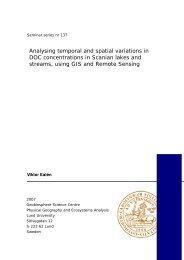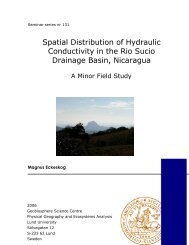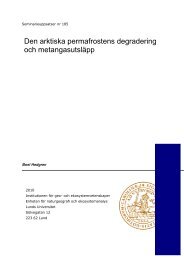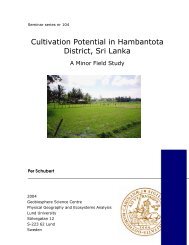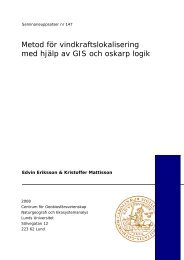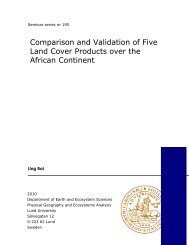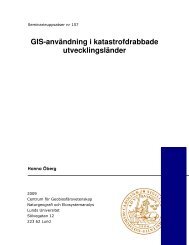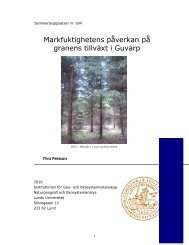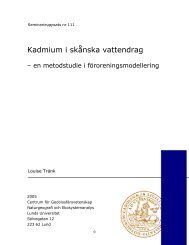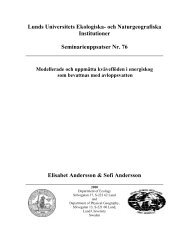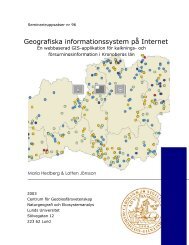Finding Potential Sites for Small-Scale Hydro Power in Uganda: a ...
Finding Potential Sites for Small-Scale Hydro Power in Uganda: a ...
Finding Potential Sites for Small-Scale Hydro Power in Uganda: a ...
You also want an ePaper? Increase the reach of your titles
YUMPU automatically turns print PDFs into web optimized ePapers that Google loves.
The primary erosive <strong>for</strong>ce determ<strong>in</strong><strong>in</strong>g the general shape of most landscapes is water. Forthis reason, most landscapes have many hilltops and few s<strong>in</strong>ks lead<strong>in</strong>g to a connecteddra<strong>in</strong>age pattern. This knowledge about surfaces is used <strong>in</strong> the ANUDEM technique <strong>in</strong>TOPOGRID, a command used <strong>in</strong> ArcGIS. It is used by impos<strong>in</strong>g constra<strong>in</strong>ts on the<strong>in</strong>terpolation process result<strong>in</strong>g <strong>in</strong> connected dra<strong>in</strong>age structure and correct representationof ridges and streams (ARC/INFO).The method consists of an iteration technique, which employs a nested grid strategy. Itstarts from an <strong>in</strong>itial coarse grid and successively calculates grids at f<strong>in</strong>er resolutions. Ithalves the cell size until the f<strong>in</strong>al user def<strong>in</strong>ed resolution is obta<strong>in</strong>ed. The <strong>in</strong>itial values <strong>for</strong>the first coarse grid are calculated by us<strong>in</strong>g the heights of local maxima based on thesurround<strong>in</strong>g contour height <strong>in</strong><strong>for</strong>mation, s<strong>in</strong>ce no other <strong>in</strong><strong>for</strong>mation on the maximumheight is available. The follow<strong>in</strong>g f<strong>in</strong>er grid resolutions are based on l<strong>in</strong>ear <strong>in</strong>terpolationfrom the preced<strong>in</strong>g coarser grid (Asserup & Eklöf, 2000).The ANUDEM technique enables a dra<strong>in</strong>age en<strong>for</strong>cement algorithm, which is designedto remove all s<strong>in</strong>k po<strong>in</strong>ts <strong>in</strong> the DEM that has not been identified as s<strong>in</strong>ks <strong>in</strong> the <strong>in</strong>putdata. The s<strong>in</strong>ks are be<strong>in</strong>g found by compar<strong>in</strong>g the height of each grid po<strong>in</strong>t with theheight of the eight immediate neighbors (ARC/INFO; Wahba, 1990).The procedure of this <strong>in</strong>terpolation has been designed to take advantage of the types of<strong>in</strong>put data commonly available, and the known characteristics of elevation surfaces. It isoptimised to have the computational efficiency of ‘local’ <strong>in</strong>terpolation methods such asInverse Distance Weighted <strong>in</strong>terpolation, without los<strong>in</strong>g the surface cont<strong>in</strong>uity of global<strong>in</strong>terpolation methods such as Krig<strong>in</strong>g and Spl<strong>in</strong>es (Hutch<strong>in</strong>son, 1989). Streaml<strong>in</strong>es aswell as contours are widely available from topographic maps and provide importantstructural <strong>in</strong><strong>for</strong>mation about the landscape. ANUDEM can use such streaml<strong>in</strong>e data,provided that the streaml<strong>in</strong>es are digitised <strong>in</strong> the downhill direction (Wilson and Gallant,2000).The result from the example <strong>in</strong>terpolation done with ANUDEM with the <strong>in</strong>put datashown <strong>in</strong> Figure 4.3 can be seen <strong>in</strong> Figure 4.4. ANUDEM generates ridges andstreaml<strong>in</strong>es from po<strong>in</strong>ts of locally maximum curvature on contour l<strong>in</strong>es. This permits<strong>in</strong>terpolation of the f<strong>in</strong>e structure <strong>in</strong> contours across the area between them. This is done<strong>in</strong> a more reliable way than methods such as Krig<strong>in</strong>g and Spl<strong>in</strong>e (Hutch<strong>in</strong>son 1988). Thederived contours also show a close match with the contours <strong>in</strong> the <strong>in</strong>put data <strong>in</strong> Figure4.3 (Gallant & Wilson 2000).36



